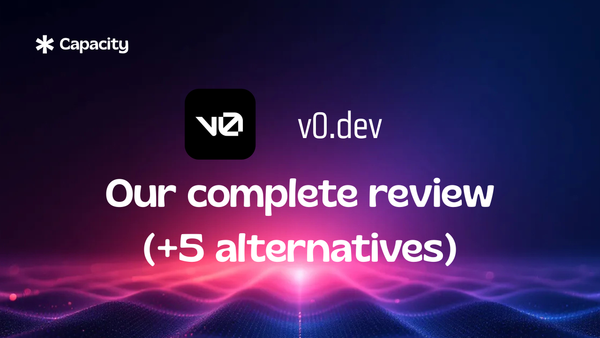What is Vibe Coding and Which Tools Should You Use ?
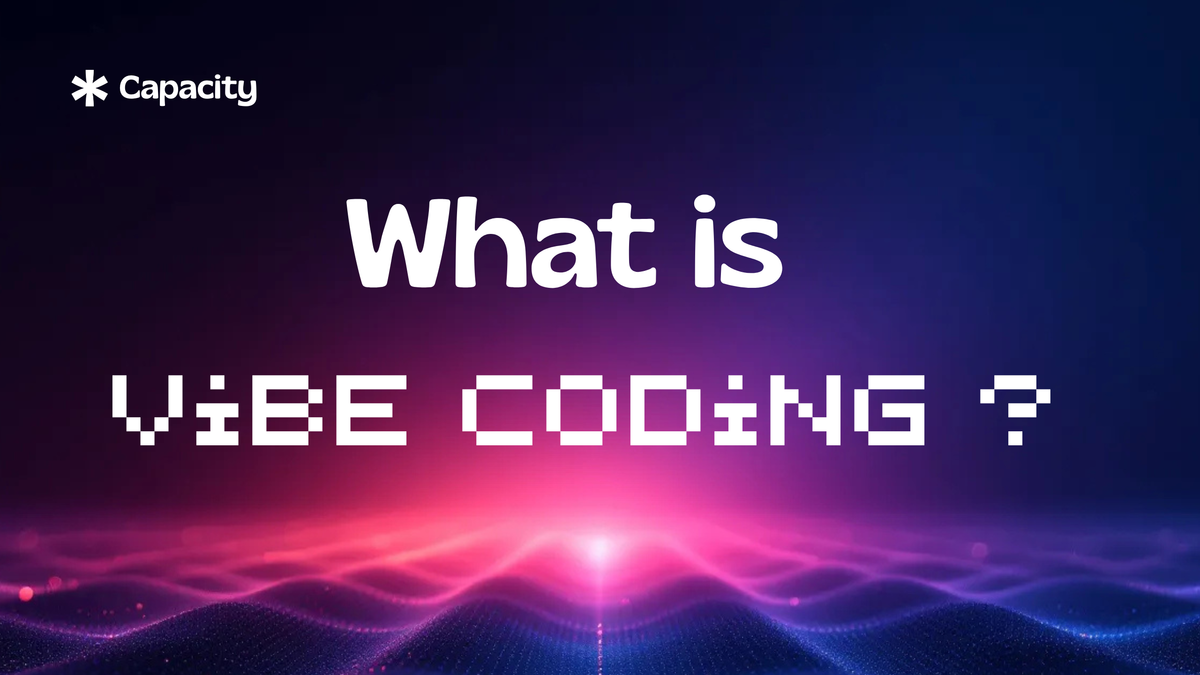
In the rapidly evolving world of software development, a new concept is gaining traction: "vibe coding." Introduced by Andrej Karpathy, a respected computer scientist and co-founder of OpenAI, vibe coding marks a notable shift in how we write code.

At its essence, vibe coding involves describing a problem or idea in natural language, and then using AI-powered tools to generate the corresponding code. This approach relies on large language models (LLMs) to streamline the coding process, enabling developers to concentrate on the creative and strategic aspects of software development rather than the repetitive details of coding.
Beyond automation, vibe coding is about democratizing app creation, making software development accessible to individuals without extensive programming expertise. Whether you're an experienced software engineer or a complete beginner, vibe coding provides a fast and efficient way to develop software.
This article explores vibe coding, its advantages and challenges, the top tools available, and how to get started with this innovative approach.
Understanding Vibe Coding
Vibe coding is more than just a trendy term; it represents a fundamental shift in the software development paradigm. At its core, it is a prompt-driven approach where developers describe their vision or requirements in natural language, and AI tools generate the corresponding code.
Here’s a deeper dive into the key aspects of vibe coding:
Core Methodologies and Techniques
Vibe coding revolves around the use of natural language prompting to instruct AI agents. Instead of writing code line-by-line, developers express their intentions in plain English, which the AI then interprets and translates into functional code. This method contrasts sharply with traditional coding, where the developer must manually translate their intent into code syntax.
AI as a Coding Partner
In vibe coding, the AI acts as a pair-programmer or assistant. The human developer's role shifts from writing every line of code to guiding the AI, reviewing its output, and providing critical feedback. This collaborative workflow allows developers to focus on high-level decisions and creative aspects, while the AI handles the detailed implementation.
Andrej Karpathy describes this process as treating the AI like an autonomous intern, where he describes what he wants, the AI writes the code, and he executes it to see if it works.
Multimodal Interaction
Vibe coding is not limited to typed prompts; it also supports voice input, making the experience even more intuitive. Tools like Cursor Composer and SuperWhisper allow developers to issue commands by voice, further blurring the lines between coding and conversation.
This multimodal interaction enhances the natural feel of coding, making it possible to build software by simply speaking your intentions.
The Role of the Developer
In the vibe coding era, the developer’s role evolves from being a hands-on coder to a director or editor.
The focus is on communicating effectively with the AI, validating its output, and refining the code as needed. Good vibe coders develop a strong sense of how to translate their vision into clear prompts and how to spot deviations from their intended outcome.
This requires a different skill set that complements traditional programming knowledge.
Iterative Refinement
The process of vibe coding is highly iterative. Developers articulate their goals, the AI generates the corresponding code, and the developers refine the output through additional prompts. This ongoing cycle of description, generation, and refinement enables rapid prototyping and continuous enhancement.
Checkpoints and version control play a vital role in maintaining project stability and ensuring manageability throughout this iterative process.
Benefits and Challenges of Vibe Coding
Benefits of Vibe Coding
Vibe coding offers several compelling benefits that are transforming the software development landscape. Here are some of the key advantages:
Increased Productivity: Vibe coding significantly reduces the time and effort required to build software. By automating the coding process, developers can focus on higher-level tasks such as design, strategy, and innovation. For instance, a Silicon Valley CEO noted that vibe coding can enable 10 engineers to do the work of 100, highlighting its potential for exponential productivity gains.
Democratization of Software Development: Vibe coding makes software development more accessible to people without extensive programming knowledge. UX designers, for example, can use vibe coding to generate working prototypes without needing to write code themselves. This democratization opens up new opportunities for non-technical individuals to contribute to software projects.
Faster Iteration and Prototyping: Vibe coding allows for rapid prototyping and iteration. Developers can quickly describe their ideas and see them come to life in functional code, enabling faster validation and refinement of concepts. This speed is particularly beneficial in the early stages of project development, where quick feedback and adjustments are key.
Intellectual Leverage: Vibe coding provides intellectual leverage by automating the thinking process itself. It shifts the focus from "building things right" to "building the right things," allowing developers to concentrate on high-return activities such as identifying novel solutions and creating new paradigms.
Challenges of Vibe Coding
Despite its benefits, vibe coding also presents several challenges that developers and organizations need to address:
Code Quality and Maintainability: AI-generated code often lacks the structure, efficiency, and foresight of human-written code. This can lead to technical debt, making the codebase difficult to debug, modify, or extend over time. The AI's output may require significant refinement and maintenance by human developers to ensure it meets production standards.
Security Risks: Vibe coding introduces security risks because LLMs can repeat patterns of code they have seen during their training, including potentially unsafe code. This can result in vulnerabilities, especially in applications handling sensitive data. Blindly trusting AI output without thorough review is dangerous and can lead to significant security issues.
Hallucinations and Debugging Issues: LLMs can sometimes generate code that includes non-existent libraries or functions, a phenomenon known as "hallucinations." These errors can make debugging more challenging, especially as the codebase grows and becomes more complex.
Maintenance and Complexity: Vibe coding excels at creation but struggles with maintenance. Complex projects require deep expertise to manage and maintain, which can be a significant challenge. Smart organizations need to develop dual skillsets to handle both rapid prototyping with vibe coding and rigorous engineering practices for production systems.
Best Vibe Coding Tools
When it comes to vibe coding, the right tools can significantly enhance your productivity and the quality of your code. Here are some of the top tools that leverage AI to make software development more efficient and accessible.
Capacity.so
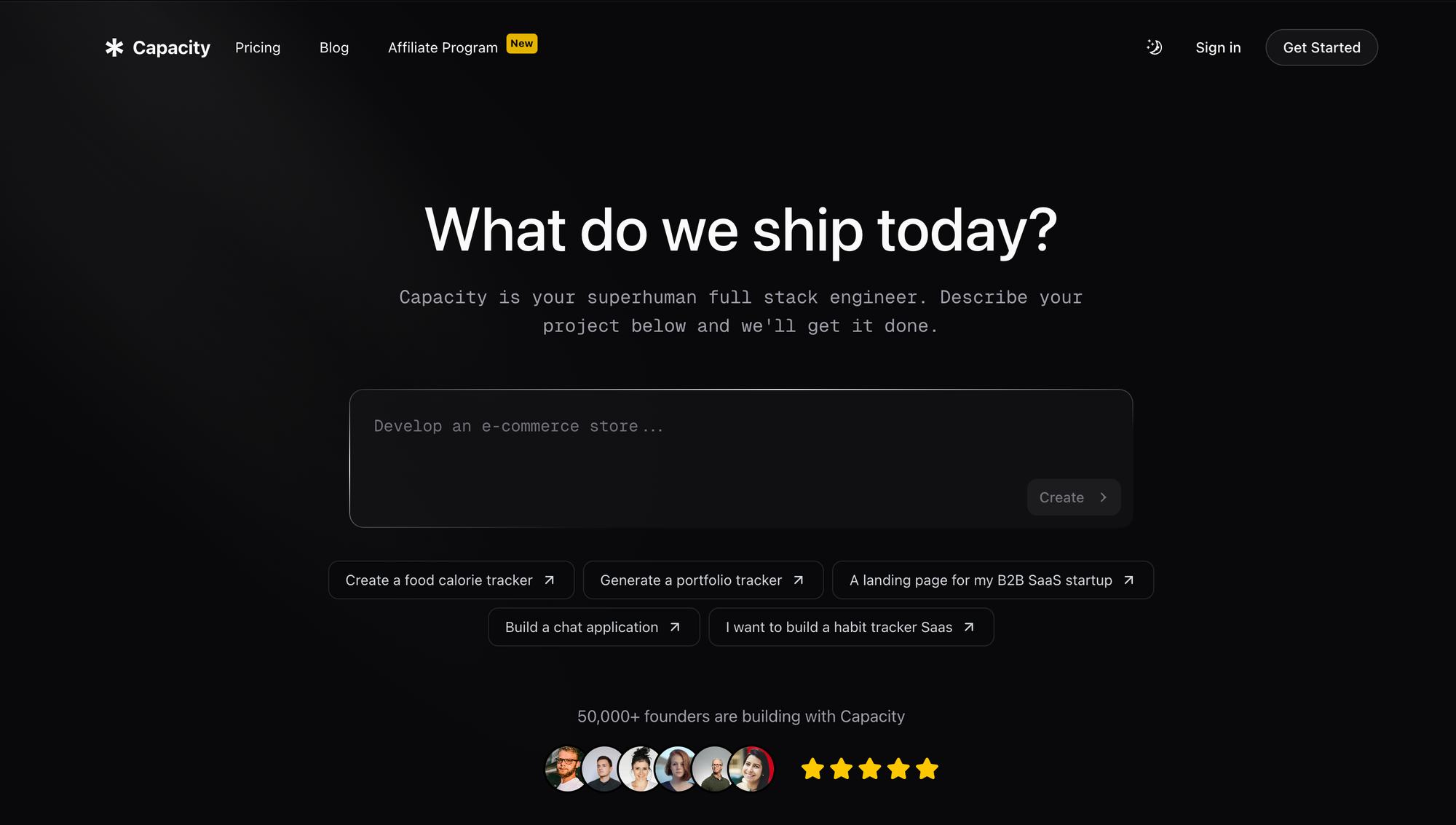
Capacity.so stands out as a premier tool for creating full-stack applications using natural language. This platform allows you to describe the application you want to build, and the AI will generate a complete, functional full-stack application in a remarkably short time. Here are some key features and considerations:
Pros:
- Speed and Reliability: Capacity.so is known for its speed and reliability in generating code. It can create a full-stack application much faster than manual coding.
- Export and Edit Capabilities: The tool allows you to export the generated codebase to GitHub and edit applications using natural language prompts.
- Comprehensive Functionality: It supports the creation of entire applications, from frontend to backend, based on your natural language descriptions.
- User-Friendly Interface: Capacity offers a user-friendly interface that makes it easy for developers and no-coders to interact with the AI and generate code.
- Contextual Understanding: The tool has strong contextual awareness, allowing it to generate code that is relevant to your project’s specific needs.
Pricing:
- Capacity.so offers various pricing plans, including a free tier for small projects and paid plans starting at around $20 per month for more extensive use. The exact pricing can vary based on the specific features and support you need.
Lovable.dev
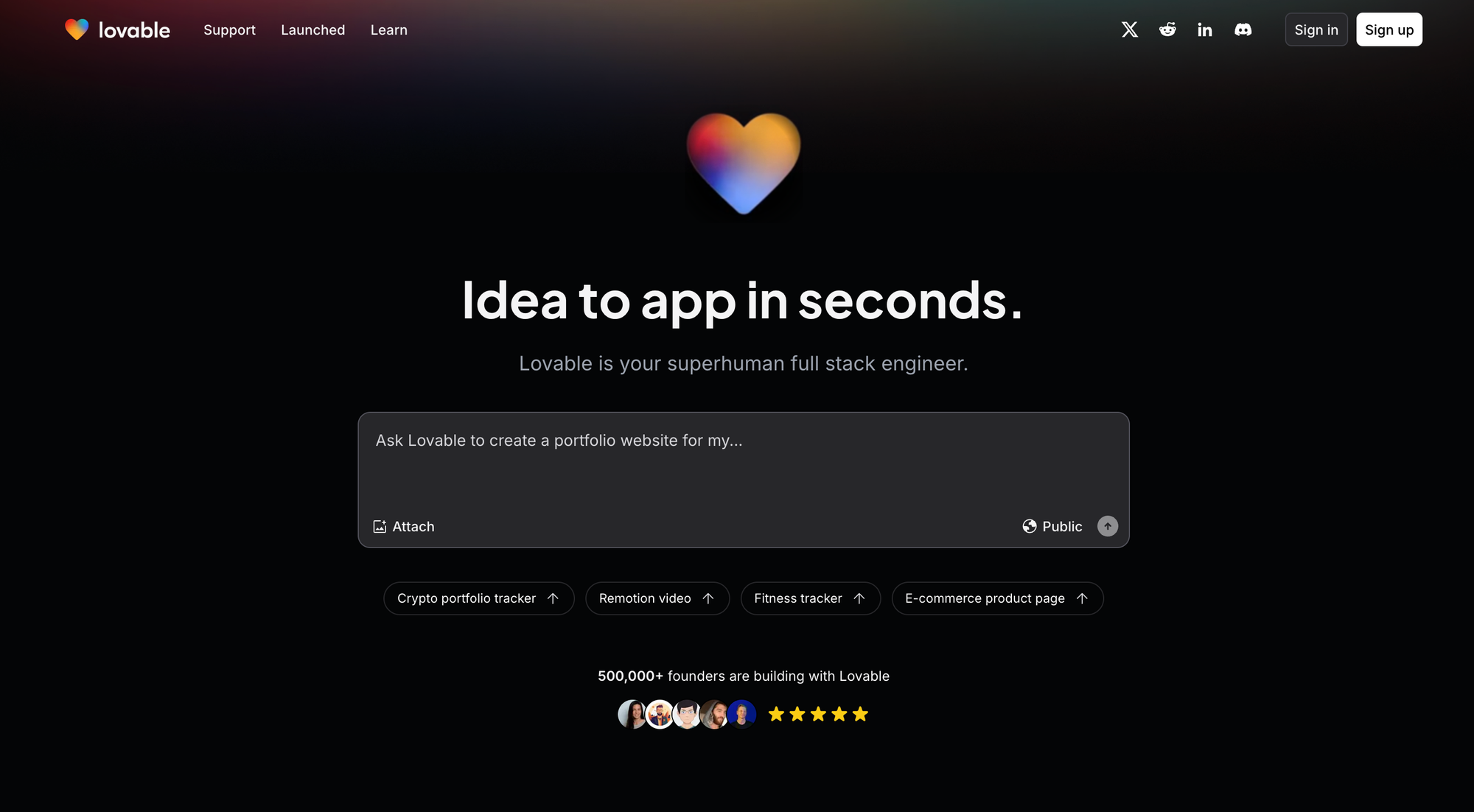
Lovable.dev is another notable tool in the vibe coding ecosystem, designed to simplify the development process through AI-driven code generation. Here’s what you need to know:
Pros:
- User-Friendly Interface: Lovable.dev boasts a user-friendly interface that makes it easy for developers to interact with the AI and generate code.
- Multi-Language Support: It supports multiple programming languages, making it versatile for various development tasks.
Cons:
- Limited Advanced Features: The free version may lack some of the advanced features available in paid plans, which could limit its utility for complex projects.
- Integration Issues: Some users have reported minor issues with integrating Lovable.dev with certain IDEs or development environments.
Pricing:
- Lovable.dev offers a free plan for individual developers, with paid plans starting at around $20 per month. The pricing structure is designed to be accessible for both small teams and larger organizations.
Cursor
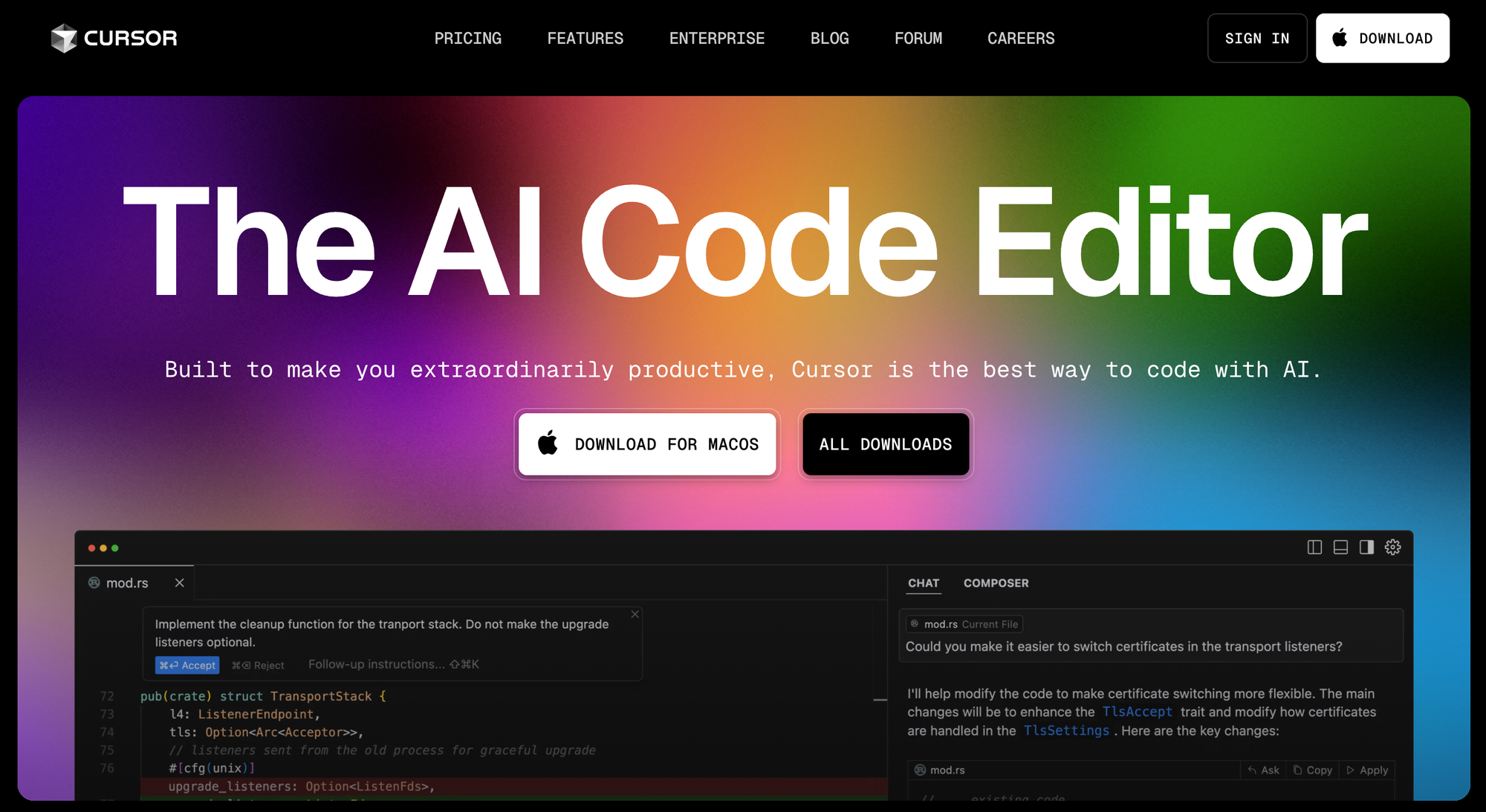
Cursor is a powerful AI-powered code editor that integrates seamlessly with Visual Studio Code (VS Code) and other popular IDEs. Here are its key features:
Pros:
- Context-Aware Suggestions: Cursor provides context-aware code suggestions, refactoring help, and codebase search capabilities, making it highly efficient.
- AI-Powered Autocompletion: It offers AI-powered autocompletion that can generate single-line codes or entire functions, reducing syntax errors and speeding up development.
- Multi-LLM Support: Cursor is compatible with multiple large language models, including Claude 3.5, GPT-4, and others, giving developers flexibility in choosing the best model for their needs.
Cons:
- Limited Language Support: While Cursor supports many languages, it may not cover all programming languages, which could be a limitation for some projects.
- Subscription Cost: The subscription fee, especially for the Enterprise plan, might be too expensive for some users.
Pricing:
- Cursor offers a free version, a Pro plan at $9 per month, and an Enterprise plan at $19 per user/month. This pricing structure makes it accessible for individual developers, small teams, and larger organizations.
Bold.new
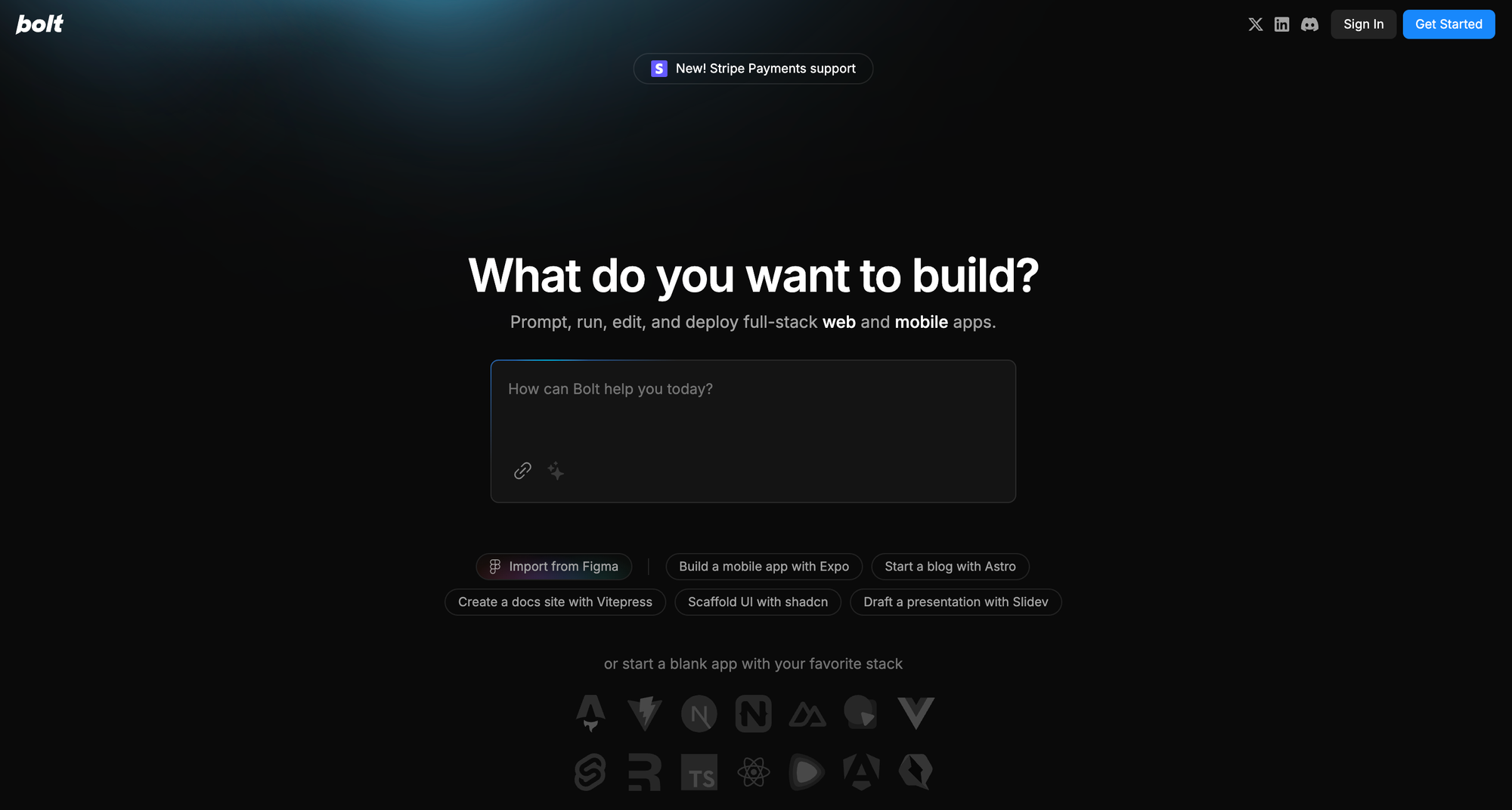
Bold.new is a relatively new but promising tool in the vibe coding space, focusing on simplifying the development process through natural language inputs. Here’s what you should know:
Pros:
- Simplified Development: Bold.new allows developers to describe their project requirements in natural language, and the AI generates the corresponding code.
- Fast Prototyping: It enables rapid prototyping, allowing developers to quickly test and refine their ideas.
- User-Friendly: The interface is designed to be user-friendly, making it accessible to both novice and experienced developers.
Cons:
- Limited Documentation: As a newer tool, Bold.new might have limited documentation and community support compared to more established tools.
- Feature Set: The feature set, while robust, might not be as extensive as some of the more mature tools in the market.
Pricing:
- Bold.new offers a free tier for small projects and paid plans starting at around $30 per month. The exact pricing can vary based on the features and support required.
Creatr
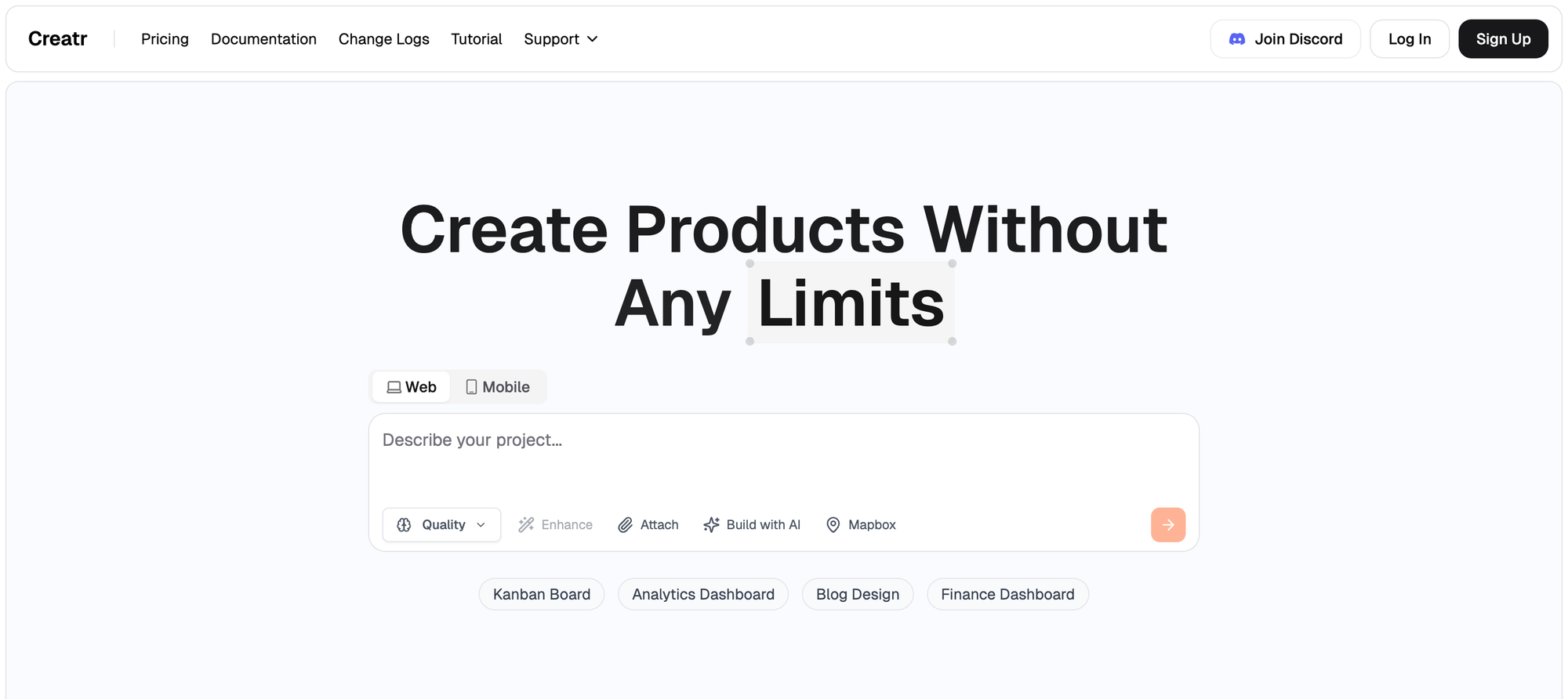
Creatr is an advanced tool that utilizes AI to optimize the software development process. Below are its key features, advantages, and drawbacks:
Pros:
- Comprehensive Code Generation: Creatr can produce complete codebases based on natural language descriptions, including both frontend and backend components.
- Customizable: The tool offers extensive customization options for the generated code, making it suitable for various project needs.
- Integration with Popular IDEs: Creatr integrates seamlessly with widely-used IDEs, ensuring a smooth development workflow.
Cons:
- Steep Learning Curve: Due to its extensive feature set, Creatr can be challenging for developers unfamiliar with vibe coding.
- Performance Issues: Users have reported performance concerns, particularly with larger projects, which may hinder development speed.
Pricing:
Creatr offers a free trial, with paid plans starting at approximately $40 per month. The pricing is designed to suit both individual developers and larger teams.
Getting Started with Vibe Coding
Choosing the Right Tools and Environment
To begin vibe coding, you need to select the appropriate tools and set up your development environment. Follow these key steps:
Selecting a Vibe Coding Tool: Tools like Capacity.so, Lovable.dev, Cursor, Bold.new, and Creatr are popular options. Each has unique features, so choose one that fits your project requirements and your comfort level with AI-driven development.
Setting Up Your IDE: Many vibe coding tools integrate seamlessly with popular Integrated Development Environments (IDEs) such as Visual Studio Code (VS Code). For instance, you can install extensions like Klein or Cursor within VS Code to enable AI-assisted coding. Ensure you download and install the required extensions and configure them according to the tool's guidelines.
Understanding Prompting Techniques
Prompting is a vital part of vibe coding. Here are some tips for crafting effective prompts:
Clear and Specific Prompts: The quality of generated code depends heavily on the clarity of your instructions. Use clear, specific, and concise prompts to describe your goals. For example, instead of saying "build a login form," say "create a secure login form with username and password fields, and include validation for empty inputs."
Breaking Tasks into Small Steps: Divide complex tasks into smaller, manageable steps. This approach simplifies the process and reduces the chance of errors. Ask the AI to "keep it simple" and focus on one step at a time.
Using Visual Aids: Including images or screenshots can provide additional context for the AI, especially for design or UI-related tasks. Visual feedback helps the AI generate more accurate and relevant code.
Planning and Project Management
Effective planning is essential for successful vibe coding projects. Here’s how you can approach it:
Vibe PMing: Start by asking the AI to create a README file that outlines project requirements, tech stack, and milestones. This method, called "vibe PMing," helps define the project scope and ensures everyone is aligned.
Keeping the Tech Stack Simple: Avoid overly complex tech stacks, especially for initial projects. Simple client-side applications with local storage are a good starting point. This simplicity minimizes the risk of unnecessary complications introduced by the AI.
Using Voice Dictation for Enhanced Experience
Voice dictation can make vibe coding more natural and intuitive:
Voice-Driven Coding: Tools like SuperWhisper allow you to interact with the AI using voice commands. This feature can make the development process more enjoyable and efficient, particularly for those who prefer speaking over typing.
Testing and Iteration
Testing and iteration are critical steps in the vibe coding process:
Reviewing and Refining Code: Always review the generated code for errors or issues. If you find any problems, copy and paste them back into the AI for resolution. This iterative process ensures that the final code meets your requirements.
Deploying Your Project: Once you are satisfied with the code, deploy your project to a hosting platform like Vercel or Firebase. This step allows you to see your application in action and make any necessary adjustments.
Best Practices for Vibe Coders
To successfully create an app from scratch using vibe coding, it's important to follow a structured approach that leverages the strengths of AI-assisted development. Here are some best practices to guide you through the process.
Start with a Clear Plan and Requirements
Before diving into code generation, define your project's requirements and create a detailed plan. This step, often referred to as "vibe PMing," involves asking the AI to generate a README file that includes project requirements, tech stack, and milestones. This helps in outlining the project scope and ensuring everyone is on the same page.
Build the Landing Page First
Begin by creating the landing page of your application. This is typically the simplest part of the app and sets the tone for the rest of the development process.
Use clear and specific prompts to describe the layout, design, and any interactive elements you want on the landing page. For example, you might ask the AI to "create a landing page with a hero section, a features section, and a call-to-action button."
Implement Authentication Pages
Next, focus on building the authentication pages. Tools like Capacity.so integrate seamlessly with Supabase, making it easy to set up user authentication.
Use prompts such as "create a login page with email and password fields, and integrate it with Supabase for user authentication." Ensure that the AI generates code that includes proper error handling and validation for secure authentication.
Build the Dashboard
After setting up authentication, move on to building the dashboard. This involves creating the core functionality of your app.
Break down the dashboard into smaller components, such as user profiles, data visualization, or key metrics. Use iterative refinement to ensure each component works as expected before moving on to the next.
For instance, you might ask the AI to "create a user profile page that displays user information and allows for profile editing."
Add Payment Processing
If your app requires payment processing, integrate a payment gateway like Stripe. Use clear prompts to guide the AI in setting up the payment flow.
For instance, you can specify: "Integrate Stripe payment processing into the app, including a payment form and a confirmation page." Ensure that the AI-generated code properly handles payment errors and displays success messages to users.
Iterative Refinement and Testing
Throughout the development process, adopt an iterative approach to refine and test each component. Test individual features in isolation to confirm they work correctly before integrating them into the larger system. Utilize feedback loops to adjust prompts and regenerate code as necessary.
This iterative refinement approach allows you to catch errors early and ensures the final product aligns with your quality standards.
Maintain Robust Version Control and Documentation
Leverage version control systems like Git to manage changes, collaborate with team members, and track the progress of your project. Regularly commit changes with descriptive messages and use branching strategies to minimize conflicts. Additionally, ensure comprehensive documentation of the codebase, particularly for AI-generated code, to provide context and support long-term maintainability.
Leverage AI for Code Review and Improvement
Utilize AI not only for generating code but also for reviewing and enhancing your workflow. Ask the AI to critique your current processes, suggest improvements, and pinpoint areas where the code can be optimized.
This collaborative approach enhances your development process and ensures the code meets high standards of quality and maintainability. By following these best practices, you can effectively use vibe coding to create robust and functional applications from scratch while preserving the quality and integrity of your codebase.
Common Pitfalls in Vibe Coding
While vibe coding offers numerous benefits, it is not without its challenges. Here are some common pitfalls to be aware of and tips on how to avoid them.
Unclear or Ambiguous Prompts
One of the most significant pitfalls in vibe coding is using unclear or ambiguous prompts. The AI relies heavily on the clarity and specificity of your prompts to generate accurate and relevant code.
Here are some tips to ensure your prompts are clear:
Be Specific: Avoid vague requests. Instead of asking the AI to "build a login system," ask it to "create a secure login system with username and password fields, including validation for empty inputs and password strength checks."
Ask for Plans First: Before asking the AI to generate code, ask it to outline its plan. This helps in identifying any potential complexities or unnecessary steps the AI might take. For example, "Tell me your plan first; don’t code."
Provide Options: Request the AI to give you several options, starting with the simplest one. This approach helps in avoiding overly complex solutions. For instance, "Give me a few options, starting with the simplest first. Don’t code."
Lack of Structure and Planning
Failing to have a clear structure and plan before starting to vibe code can lead to disorganized and inefficient development. Here’s how to mitigate this:
Create a Basic Plan: Develop a guideline or a basic plan of what you want to achieve before interacting with the AI. This helps in maintaining focus and ensuring that the AI-generated code aligns with your overall project goals.
Break Tasks into Small Steps: Divide complex tasks into smaller, manageable steps. This approach keeps the development process simple and reduces the likelihood of introducing unnecessary bugs. Ask the AI to "keep it simple" and focus on one step at a time.
Blindly Accepting AI Output
Another common mistake is blindly accepting the code generated by the AI without proper review. Here’s why this is problematic and how to avoid it:
Review and Refine: Always review the generated code for logical errors, performance issues, and security vulnerabilities. Ask the AI to explain the code it generated, which can help you understand and validate its output. For example, "Explain how this file works in simple terms" or "Add comments that explain the code."
Test Thoroughly: Test the generated code thoroughly, especially in a local environment, to catch problems early. Use browser consoles and debugging tools to identify and fix issues promptly.
Ignoring Security and Performance Implications
Vibe coding can introduce security risks and performance bottlenecks if not managed properly. Here are some tips to address these concerns:
Security Risks: Be aware that AI-generated code may not anticipate potential security threats. Use security checklists and workshops, such as those offered by Snyk, to uncover and fix vulnerabilities in AI-assisted coding.
Performance Optimization: Since AI tools often prioritize correctness over efficiency, ensure that you optimize the generated code for performance. Regularly review the code for any performance bottlenecks and ask the AI to suggest optimizations.
Over-Reliance on AI
While AI is a powerful tool, relying too heavily on it can result in a lack of understanding of the underlying codebase. To strike a balance between AI assistance and manual oversight, consider the following:
Understand the Codebase: Even if you're using AI to generate code, it’s essential to grasp the technical details of your codebase. Ask the AI to explain the code in simple terms, and ensure you have a thorough understanding of its functionality.
Manual Review and Maintenance: Regularly review and maintain the codebase manually to keep it lean, secure, and efficient. This includes identifying and addressing issues like code bloat, unnecessary implementations, and other potential problems arising from AI-generated code.
By recognizing these common pitfalls and applying these strategies, you can better navigate the challenges of vibe coding, ensuring your projects are both successful and maintainable.
Choosing the Right Tools for Your Needs
Selecting the right vibe coding tool is essential for maximizing productivity and ensuring that your development process aligns with your project's specific needs. Here are some key considerations and tool recommendations to help you make the best choice.
Evaluating Your Project Requirements
Before choosing a tool, it's essential to evaluate the specific requirements of your project. Consider the complexity, the need for integration with other tools, and the level of customization required. For example, if you're building a full-stack application, you might prioritize tools that excel in this area.
Capacity.so for Full-Stack Applications
Capacity.so stands out as the #1 tool for creating full-stack applications using AI. It allows you to describe your application in natural language, and the AI generates a complete, functional full-stack application. This tool is particularly useful for its speed, reliability, and the ability to export the codebase to GitHub and edit apps using natural text prompts.
Cursor for AI-First Code Editing
If you prefer an AI-first code editor, Cursor is an excellent choice. Built on VS Code, Cursor deeply integrates AI into every layer of the editing experience.
It offers context-aware autocomplete, inline debugging, and refactoring with natural language prompts, making it ideal for fast iteration and onboarding into unfamiliar codebases.
Copilot Workspace for Task-Oriented Development
Copilot Workspace is a task-oriented tool that tackles full development cycles. It can understand GitHub issues, break them into subtasks, write full PRs, and summarize its actions.
This makes it perfect for junior developers, product engineers, or teams with many open tickets to manage.
Lovable.dev for No-Code and Low-Code Development
Lovable.dev is an excellent choice for those seeking no-code or low-code solutions. It enables users to describe their application ideas in plain English, which the platform then converts into functional code.
With features like live rendering, collaborative tools, and integration with design platforms like Figma, it caters to users of all skill levels, making development more accessible.
Bolt.new for Rapid Prototyping and Deployment
Bolt.new is an AI-driven web development tool designed for rapid prototyping and deployment of full-stack web and mobile applications directly from the browser. It integrates seamlessly with design tools, allowing users to prompt, run, edit, and deploy applications efficiently.
This tool is perfect for individuals who want to quickly transform ideas into reality without the complexities of traditional development.
Considerations for Integration and Customization
When selecting a tool, it's important to evaluate its integration capabilities and customization options. For example, tools like Apidog MCP Server are highly effective for projects that depend on APIs, as they integrate seamlessly with existing API documentation and offer contextual awareness.
Additionally, consider the level of control you require during development. Tools such as Cursor and Copilot Workspace provide advanced features and deep integration with popular IDEs, offering enhanced flexibility and control for experienced developers.
Community Support and Updates
Community support and regular updates are essential factors to consider. Choose tools backed by active communities, frequent updates, and versatile applications to ensure your work remains relevant and adaptable over time.
By carefully assessing these aspects and selecting the right tool for your needs, you can fully leverage vibe coding to streamline your development process and boost productivity.
Conclusion
Vibe coding is revolutionizing the software development landscape by leveraging AI to generate code from natural language prompts. To successfully embrace this technology, it is essential to follow best practices and maintain a clear understanding of the process.
Verify every line of code generated by the AI to ensure accuracy and functionality. Use clear and specific prompts to guide the AI effectively, and break tasks into small, manageable steps for better results. Keep your tech stack simple and choose tools like Capacity.so, Cursor, and Lovable.dev that align with your project requirements.
Understand your codebase thoroughly and avoid blindly accepting AI-generated output. Employ version control systems to save and track changes, enabling better collaboration and error management. Focus on intellectual leverage by automating repetitive thinking processes, allowing you to concentrate on innovation and problem-solving.
By following these best practices and avoiding common pitfalls, you can harness the full potential of vibe coding. Whether you are a seasoned developer or a newcomer to software development, start your vibe coding journey today. With the right tools and mindset, you can create innovative applications quickly and efficiently, unlocking new possibilities in the world of software development.
FAQ
What does vibe coding mean?
Vibe coding is an AI-driven programming technique where a person describes a problem in natural language to a large language model (LLM), which then generates the software code. This method redefines the programmer's role to focus on guiding, testing, and refining the AI-generated code, rather than manually writing it.
What is Vibecode?
Vibecoding, or vibe coding, is an AI-driven programming method where a user describes a problem in natural language to a large language model (LLM), which then generates the software code. The programmer's role shifts to guiding, testing, and refining the AI-generated code, often without needing to fully understand the intricacies of the generated code.
What is vibing coding?
Vibe coding is an AI-driven programming approach where users describe a problem in natural language to a large language model (LLM), which then generates the software code. This technique enables non-technical users to create software by focusing on guiding, testing, and refining the AI-generated code, without requiring extensive programming skills.
What is vibe coding with AI?
Vibe coding with AI is a programming technique introduced by Andrej Karpathy. It involves users describing a problem in natural language, and a large language model (LLM) generates the corresponding code. This approach shifts the programmer's role to guiding, testing, and refining the AI-generated code, rather than manually writing it.
This technique facilitates rapid prototyping and development, particularly for hobby projects or small-scale applications. However, it raises concerns about code quality, debugging, and accountability.
